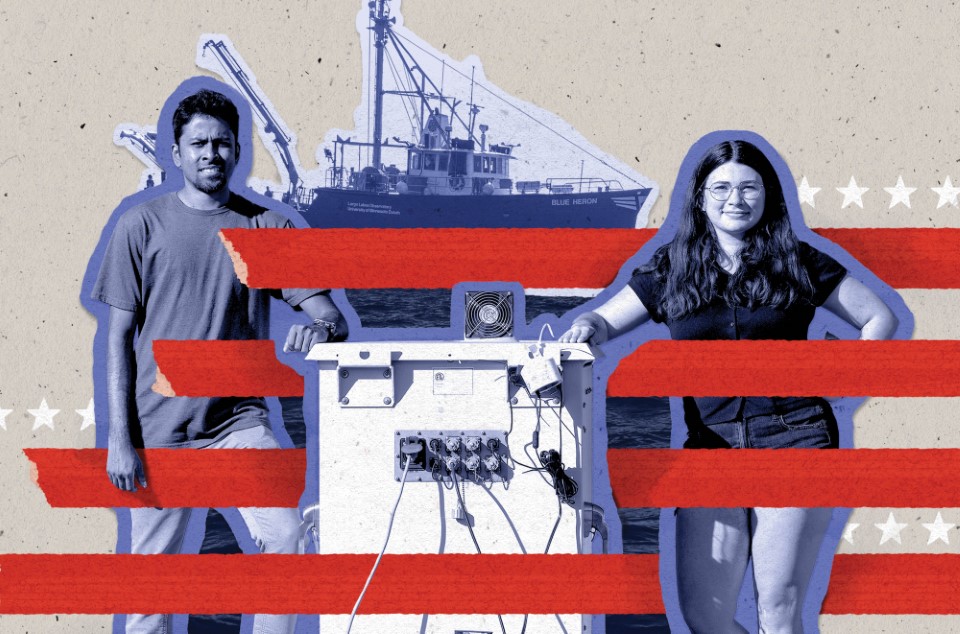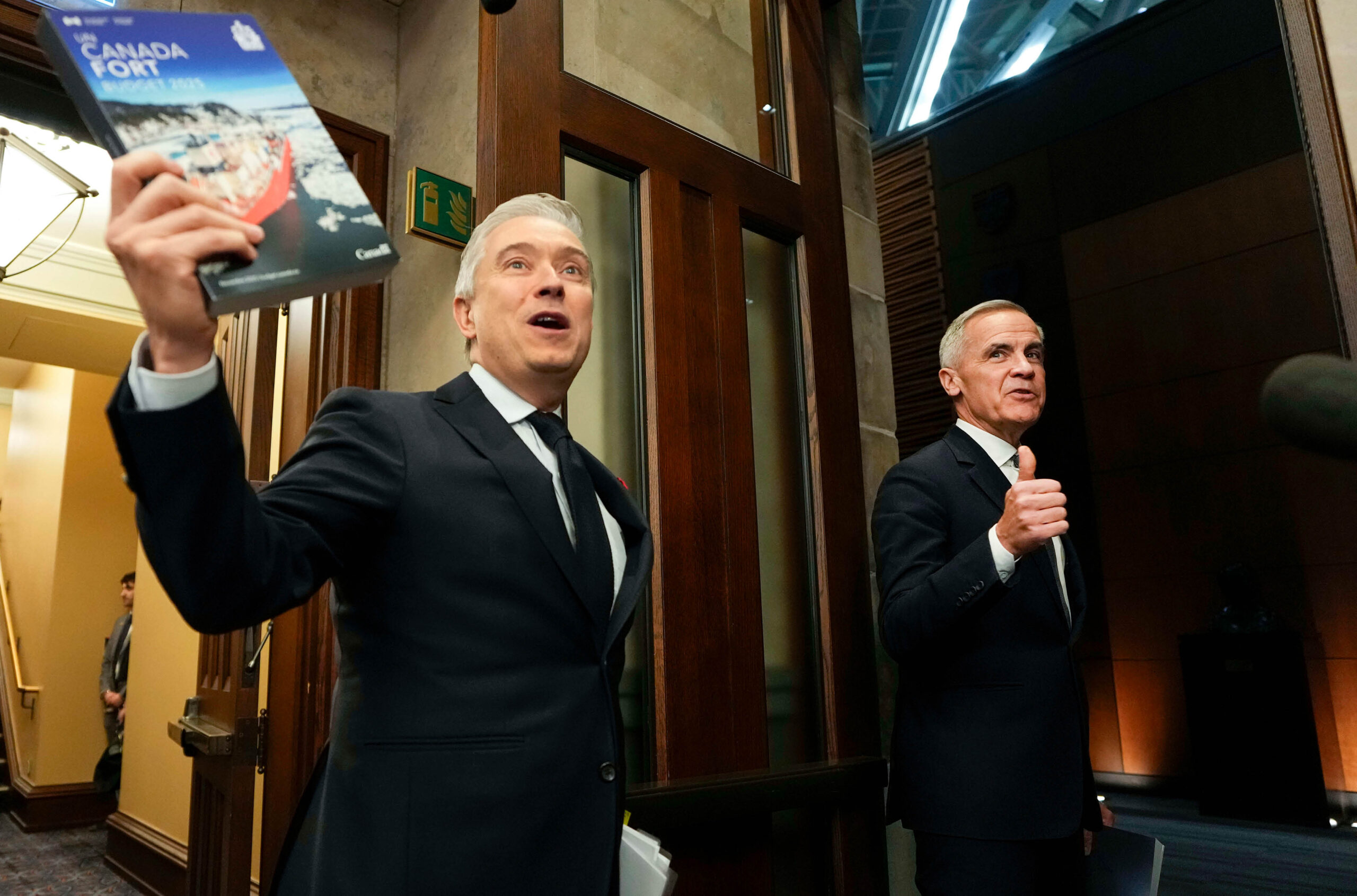Science interrupted
How the Trump administration’s cuts to U.S. science are derailing Canadian research.

In early spring this year Aaron Fisk and his colleagues were preparing for their usual field season, planning to deploy bright yellow autonomous gliders in the Western Basin of Lake Erie. The goal was to study what happens as the lake transitions from winter to summer and how nutrients, temperature and other factors affect algal blooms and water quality.
But then the Trump administration began making major cuts to the National Oceanographic and Atmospheric Administration (NOAA), the agency that works closely with Canadian scientists on research in the Great Lakes, providing money, ships and equipment for many joint projects. Funding that had already been promised was cancelled or delayed, and long-time scientific collaborators at the agency were suddenly fired.
Although the initial deployment was delayed by late ice, it should have been possible to get out on the water within a week of the planned start date using an icebreaker, says Dr. Fisk, an ecologist at the University of Windsor and science director of the Real-Time Aquatic Ecosystem Observation Network (RAEON). “But then things got so chaotic with NOAA that everything shut down,” he says, and the spring glider deployment was cancelled.
“We don’t know what is happening and it can change from moment to moment.”
“Trump’s cuts really stymied some of the projects we wanted to do this summer,” he says. “We missed an opportunity to collect important data to understand what’s going on. It’s a hole in the dataset that compromises our ability to forecast and prepare for changes.”
Data gaps like that are particularly problematic given how rapidly the aquatic environment is changing, he adds, as climate change drives rapid warming in the Great Lakes.
RAEON is a Canadian program that provides instruments to scientists across Canada to conduct research on aquatic ecosystems, particularly in the Great Lakes, but it works closely with researchers and government agencies in the U.S.
“If you work in the Great Lakes, you collaborate with American colleagues. There’s almost no border with regards to research on the Great Lakes,” says Dr. Fisk. “A lot of the equipment RAEON buys has never even been in Canada. It stays in and is deployed from Ann Arbor [Michigan] by our colleagues there.”
Jérôme Marty, executive director of the International Association for Great Lakes Research, says the Trump administration’s cuts are affecting scientists working on projects all around the lakes, from invasive species control, to cleaning up legacy pollution. But almost more disruptive than the loss of funding is the uncertainty around whether things will ever settle down into a new normal. “Things are extremely fluid, and chaos is the only certainty,” he says. “We don’t know what is happening and it can change from moment to moment.”
From lakes to space
That chaos is a common thread throughout Canada’s scientific partnerships with the U.S. Collaborations with NASA have also been thrown into disarray as projects are cancelled and scientists fired or forced into retirement. The Canadian Space Agency is providing one satellite and three scientific instruments to NASA’s Atmosphere Observing System mission, a constellation of four satellites to measure aerosols, clouds and water vapour in the atmosphere and how they affect weather, air quality and climate.
But now the mission is in jeopardy, targeted by the Trump administration because of its connection to climate science, according to Aldona Wiacek, an atmospheric scientist at Saint Mary’s University in Halifax. “Canada invested $200 million to build these instruments, and now one of them may be without a spacecraft,” she says.
Ground-based atmospheric science is also facing disruptions. Dr. Wiacek is co-principal investigator, along with physicist Robert Sica from Western University in London, of the Canadian Micro-Pulse Lidar Network (MPLCAN). It is part of a global network coordinated by NASA to track wildfire smoke and other pollutants in the atmosphere. But NASA’s contribution to the network appears to be on the chopping block, and the long-time NASA scientist who built and ran it has taken early retirement.
“The official word is the project is still on, but all the key people have left and there is no U.S. money for it after January,” says Dr. Sica.
MPLCAN will continue its work, but the loss of NASA’s central coordinating role, connecting the various participants and providing data processing and other support like instrument calibration is not something that is easily replaced by any of the other international partners, notes Dr. Sica. “In five years, we could maybe make a poor version of what they do,” at a cost of around $500,000 CAD a year, he says.
Beyond the loss of technical support and coordination, NASA’s retreat from atmospheric and climate science is a huge blow to a field whose main strength is international cooperation.
“We’re better together,” insists Dr. Sica. “Climate and weather is a global problem, the work can’t be done in one country without reference to others.”
Unhealthy situation
Canadian researchers also work closely with their U.S. colleagues on medical research, often holding subawards as part of larger grants from the U.S. National Institutes of Health led by colleagues at American universities. But these grants have also not been spared from Trump’s cuts. Many of them, particularly ones focusing on the social determinants of health and LGBTQ+ issues, have been terminated, including several at Canadian universities.
The National Institutes of Health (NIH) has also changed the way it funds international collaborations. In May it announced that it would no longer allow researchers in foreign countries to hold subawards. The new policy published in September requires international collaborators to submit their own grant application, attached to the main U.S. grant but reviewed separately.
Vincent Poitout, vice-rector of research and innovation at Université de Montreal, says even though the overall amount of money Canadian researchers receive from NIH is small – usually just 1-4% of a university’s total research budget – losing it will have a major impact on some high-performing researchers. “There are some very competitive teams that get around 70% of their funding from NIH subawards,” he says.
The University of Manitoba has received US$5 million in funding for 45 projects from the NIH over the past three years, says Mario Pinto, the university’s vice-president of research and international. Five NIH projects with subawards held by researchers at the University of Manitoba, worth a total of US$220,000 in the 2025-26 fiscal year, have been terminated. Three other subawards and one primary grant at the university are continuing.
The cancelled grants include studies on enhancing drug delivery to the brain, health inequities related to the HIV and substance use epidemics, and infant mortality in India. “There aren’t many, but they are very critical grants with exciting deliverables,” says Dr. Pinto.
Still, he says he is cautiously optimistic that solutions will be found and Canadian researchers will still be able to receive direct grants under the new rules introduced in September, but he adds that it is disturbing that the U.S. administration is targeting research it considers “woke”.
“Social justice and human rights is one of our strategic research themes, and we hold it dearly,” Dr. Pinto says. “It will definitely compromise our collaborations.”
“People who have built collaborative relationships with labs in the U.S. over 20 years are suddenly being forced to find someone else to work with.”
While the loss of funding is a blow to many researchers, Dr. Poitout says the disruption to longstanding research relationships is just as damaging. “People who have built collaborative relationships with labs in the U.S. over 20 years are suddenly being forced to find someone else to work with,” he says. “That’s not something you can measure in terms of money.”
Wide-ranging impact
Given the scale and scope of research funding in the U.S., any disruptions there have broad implications for research in Canada and around the world.
“The U.S. leads on many advanced research issues, including biotech and artificial intelligence, so when the U.S. stops leading it has implications for knowledge advancement and research overall,” says Robert Asselin, chief executive of the U15 group of research-intensive universities. “Less collaboration and less funding weaken the research offering in Canada.”
And it is not just in research that Canada often follows the U.S. lead, says Félix Proulx-Girardeau, interim executive director of the scientific advocacy group Evidence for Democracy. They have also been a role model in scientific governance and leadership. The departmental scientific integrity policies being put in place by Canada’s Chief Scientific Adviser were largely modelled on that of the Environmental Protection Agency, which has now rolled back its own policy to what it had in place in 2012, losing more than a decade of progress, he says.
Researchers and universities are already taking steps to deal with the disruptions to funding. Dr. Poitout says there has been a surge of interest in the European Union’s Horizon Europe funding program, which Canada joined in July 2024, though he cautions that it is a very different funding mechanism with different goals, and it alone cannot entirely fill the gap.
Université de Montreal has also launched a $25 million philanthropic campaign, in part to create a bridge funding mechanism to help give teams who have lost their U.S. money time to find alternative sources of funding. “We’ve had a fantastic response from a couple of our big donors who really are concerned about Canadian science,” says Dr. Poitout.
The cuts could also be an opportunity to attract new talent to Canada, or convince Canadians to return home. “Researchers in the U.S. are coming to the realization that there are other places with more opportunities, so it is up to Canada to demonstrate that,” adds Dr. Asselin.
Some are already on the move. Epidemiologist Yukiko Asada spent 20 years at Dalhousie University in Halifax before taking a position at NIH in 2022, studying health inequity. But after Trump took power in January, she found it increasingly difficult to do her work which, she says in an open letter published online by University Affairs, is “the diametrical opposite to what the Trump administration promotes”. Her funding was cut, her department chief fired without explanation, and in June she resigned her position and returned to Canada. Dr. Asada is taking up a new position at McMaster University in Hamilton next year.
With fortuitous timing, the latest round of applications for Canada Excellence Research Chairs opened in January. At the University of Manitoba, Dr. Pinto notes he is already seeing evidence of an increased desire to work in Canada from U.S.-based researchers. “We have had some stellar U.S. applicants for our Tier 1 Canada Research Chairs,” he says.
The Liberal Party’s election platform promised to increase funding for scientific infrastructure and research grants, particularly in health research, and proposed creating the Canadian Sovereignty and Resilience Research Fund to attract researchers affected by policy changes in the U.S. And industry minister Mélanie Joly highlighted Canada as a destination for foreign researchers at a press conference in Vancouver in July.
“Less collaboration and less funding weaken the research offering in Canada.”
“To all the researchers of the world watching us right now I want you to think about Canada being the premier destination for your work,” said Ms. Joly. “We have cutting-edge infrastructure, we have strong financial support, and we also invest in excellence. My message to you is Canada is not for sale, we’re open for business, and we’re open for science.”
The government seems to be backing those words with real money. The 2025 federal budget included $1 billion over 13 years to recruit exceptional international researchers and another $133 million over three years to recruit graduate students to Canadian universities, as well as $400 million over seven years to boost research infrastructure to support their work.
And while the budget also included a two per cent cut to the budgets of the three main research councils, it was much less than the 15 per cent cut that researchers had feared and leaves the promised increase from the 2024 budget largely intact. That “provides an encouraging investment into next-generation researchers and research support systems,” says Dr. Proulx-Giraldeau.
“The government understands that prioritizing investments in research talent, infrastructure and innovation is key to laying the foundation for a future driven by science and evidence,” he says.
No other country, or group of countries, will be able to replace what is being lost in U.S. funding and collaboration, however. Ultimately, Canada’s researchers will need the Canadian government to step up to try and fill the gap. “This is an unfortunate wake-up call for the Canadian government,” says Dr. Asselin. “It needs to reinforce its own research ecosystem and funding so our researchers are not penalized as a result of these cuts.”












Post a comment
University Affairs moderates all comments according to the following guidelines. If approved, comments generally appear within one business day. We may republish particularly insightful remarks in our print edition or elsewhere.